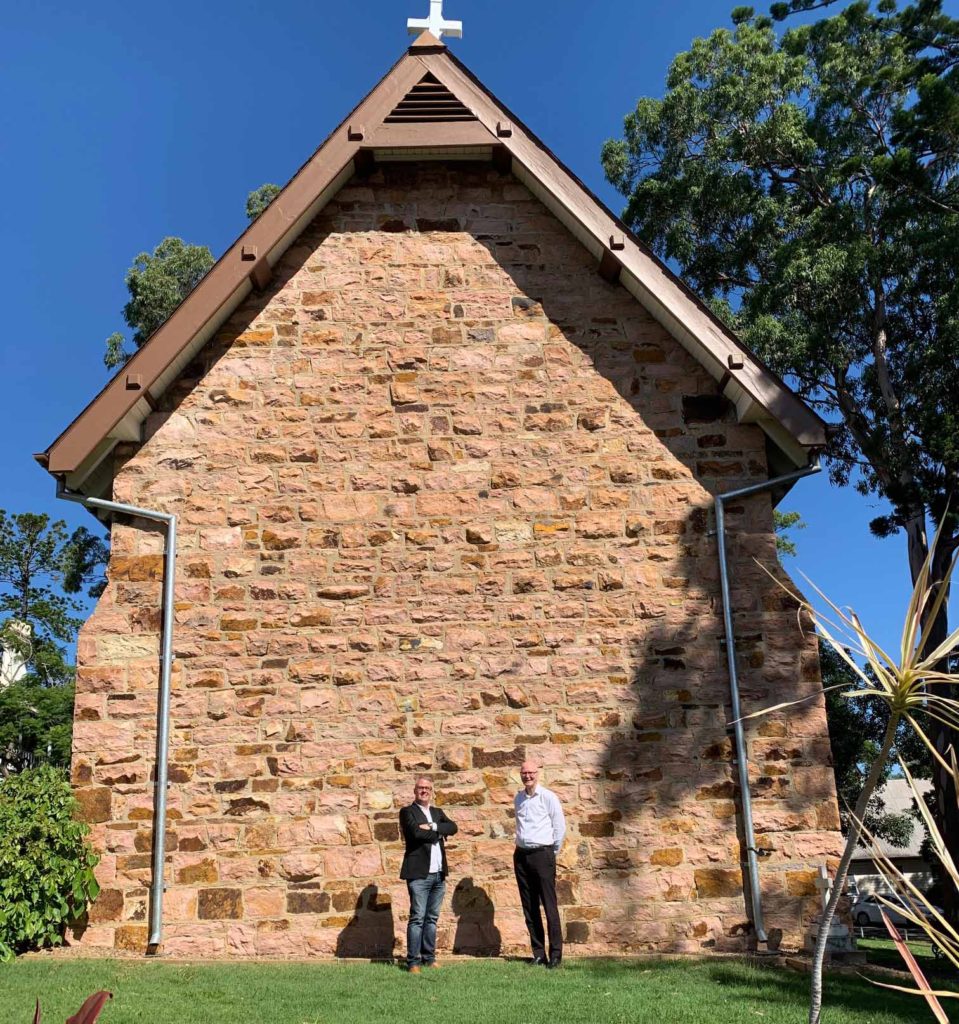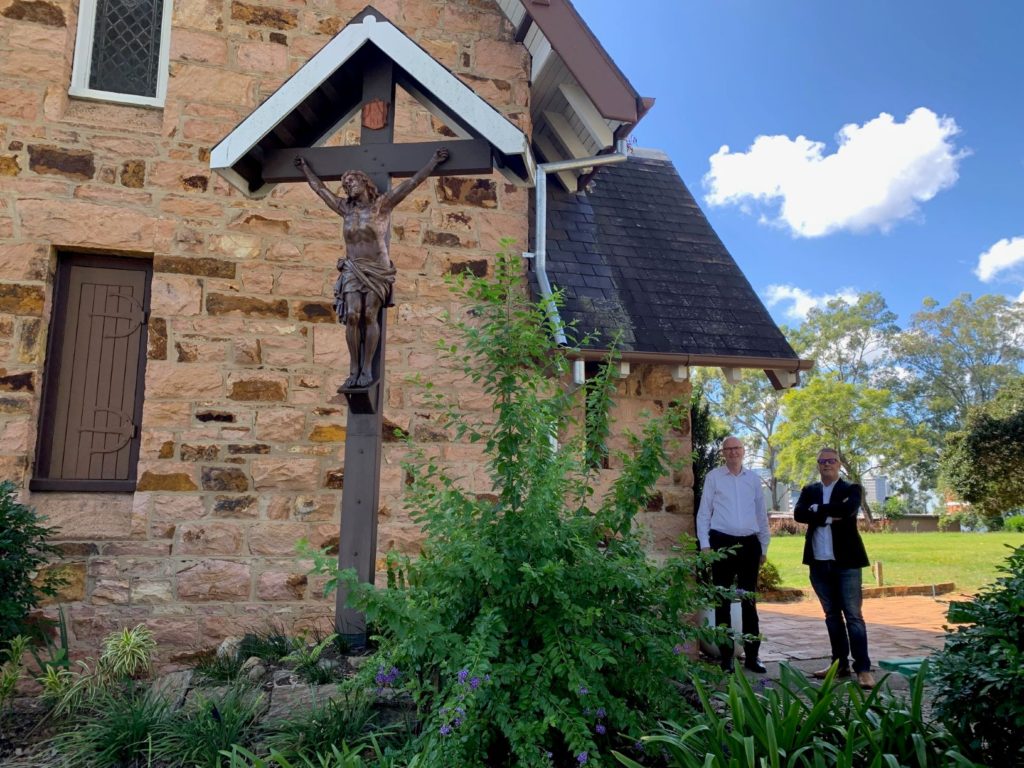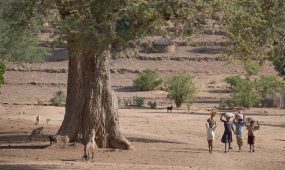Chapel of The Holy Spirit gets a facelift
News
The spiritual heart of St Francis College is currently undergoing exciting heritage conservation works with generous funding from the Queensland Government – find out what Community Sustainability Action heritage conservation funding you may be able to apply for and how

The spiritual heart of St Francis College is currently undergoing exciting heritage conservation works, following generous funding support granted by the Queensland Government.
Principal of St Francis College Bishop Jonathan Holland said that the beautiful chapel has much historic and contemporary significance.
“The chapel is used for Morning and Evening Prayer on weekdays and the Eucharist on Sundays for the Parish of Milton. It is further used by the whole community for weddings, funerals, baptisms, commissionings, prayer gatherings and art exhibitions,” Bishop Holland said.
“It used to be the chapel of the Anglican Archbishops of Brisbane when they resided onsite in Old Bishopsbourne.
“Prayers have been said and services held in the Chapel of The Holy Spirit since it was consecrated in 1912, with the exception of a single interruption in 2020 due to COVID-19.”
The works on the chapel were made possible with funding provided under Rounds 3 and 4 of the Community Sustainability Action (CSA) grants program, which is administered by the Department of Environment and Science (DES).

Principal of St Francis College Bishop Jonathan Holland and ACSQ Development Manager Shane Djordjewitsch outside the Chapel of the Holy Spirit, St Francis College on 27 April 2021: works on this side of the Chapel included repair of timber barges and a gable vent; new galvanised downpipes; new stormwater pits and grates; new gravel margin to the eastern edge of the Chapel; replacement of purlin ends; and, replacement of decayed scotia mould
Eight of the 53 heritage conservation projects approved under Round 3 and Round 4 of CSA funding are projects within our Diocese, and also include works on the Cathedral; St Mary’s, Kangaroo Point; the rectory of Christ Church, Milton; St Mark’s, Warwick; Old Bishopsbourne at St Francis College; and, the Hall of St Luke’s, Toowoomba.
ACSQ Development Manager Shane Djordjewitsch said that CSA heritage conservation grant announcements are made on an ad hoc bases, with specific eligibility criteria and a detailed process applying.
Advertisement
“To meet the eligibility criteria for CSA grants you must be the owner of a property listed on the State Heritage Register, in accordance with the Queensland Heritage Act 1992,” Mr Djordjewitsch said.
“Funding announcements are made intermittently, with the most recent being Round 5, which closed on 19 April 2021.
“The online application process is often involved and time consuming, so it’s important to have all necessary information available regarding project scope, heritage approval, costings, insurances, and the like. In some situations, it might help to engage the services of a heritage architect to assist in writing the online application.”
Projects that demonstrate best practice heritage conservation and are supported by a work schedule documented in a conservation management plan are given priority. So, having a conservation management plan is a good idea for heritage listed places. Grants were also available for the preparation of a conservation management plan in Round 5.
The primary focus of the works should be around heritage conservation, rather than improvements to the building or site.
Advertisement
The type of works, which can apply to such heritage buildings under these grants, are categorised under two distinct certificate areas.
Firstly, the General Exemption Certificate: Queensland Heritage Places, where no application is required. This option provides upfront approval for most minor works and maintenance to keep eligible heritage places in active use and operational condition. This certificate outlines strict limitations and conditions to the type and scope of works and how these are to be carried out.
The second category is a Heritage Exemption Certificate, which can be applied for via the Department of Environment and Science. This option provides approval for low-impact development, conservation works and simple projects that only affect the heritage value of a place in a minor way. According to the DES website, the kinds of work this certificate covers include, “painting in a compatible or historic colour scheme, replacing non-significant fittings or fixtures or refurbishing less important parts of a building or place.”
There is no application fee for a Heritage Exemption Certificate; however, the approval does require a formal submission to the Department, with a decision regarding approval made within 20 business from receipt of application.
To keep abreast of funding announcements, it’s best to monitor the Department of Environment and Science (DES) website.
Mr Djordjewitsch said that works carried out on the Chapel of The Holy Spirit under the Round 3 funding met the criteria of a Heritage Exemption Certificate, which he successfully applied for.
“The grant funding approved by the Department of Environment and Science was $23,600 (excluding GST), with St Francis College contributing an additional $18,000 of bequest money to undertake the works,” he said.
Mr Djordjewitsch said that works continue with Round 4 funding, with hopes for further funding to be granted following a recent Round 5 application.
“Our Diocese received $35,000 under Round 4 of the CSA grants program, which is being used to replace the ridge capping to the main roof structure and above the porch entry. New gravel margins are also being installed to the northern and southern elevations of the Chapel.
“An application was made for $40,000 under Round 5 funding in April. If successful, this money will be used to replace the existing footpath network around the periphery of the Chapel.”
CSA grants have provided $18 million over six years to eligible community groups. To date, a total of over $13.7 million have been allocated to 361 different projects under the CSA program.

Principal of St Francis College Bishop Jonathan Holland and ACSQ Development Manager Shane Djordjewitsch outside the Chapel of the Holy Spirit, St Francis College on 27 April 2021: works on this side of the Chapel included cleaning and painting of gutters, inside and out; new galvanised downpipes; a new gravel margin to the western edge of the Chapel; reproduction of similar look with galvanised downpipes; repainting of timber shutter
Mr Djordjewitsch said that the Round 3 building works were completed by Nev Paterson and Sons Pty Ltd (NPS) builders, who specialise in working on heritage listed buildings.
“They did a great job and worked well with our staff on site. NPS also completed the insurance repair work to St John’s Cathedral after sustaining severe storm damage a number of years back,” he said.
Bishop Holland said that the grant funding is significant for our Diocese, the wider Brisbane community and future generations.
“The Queensland Government funding is important because it is only through the State’s generous support that we can maintain historic buildings like the Chapel of The Holy Spirit to the standard they deserve for the benefit of our communities and future generations.”
Prior to the lodgement of paperwork, draft ACSQ parish, ministry and school Community Sustainability Action grant documentation needs to be sent to the General Managers Office, along with supporting documentation.
For more information, please email csagrants@des.qld.gov.au or call the grant program office on 07 3330 6360.






